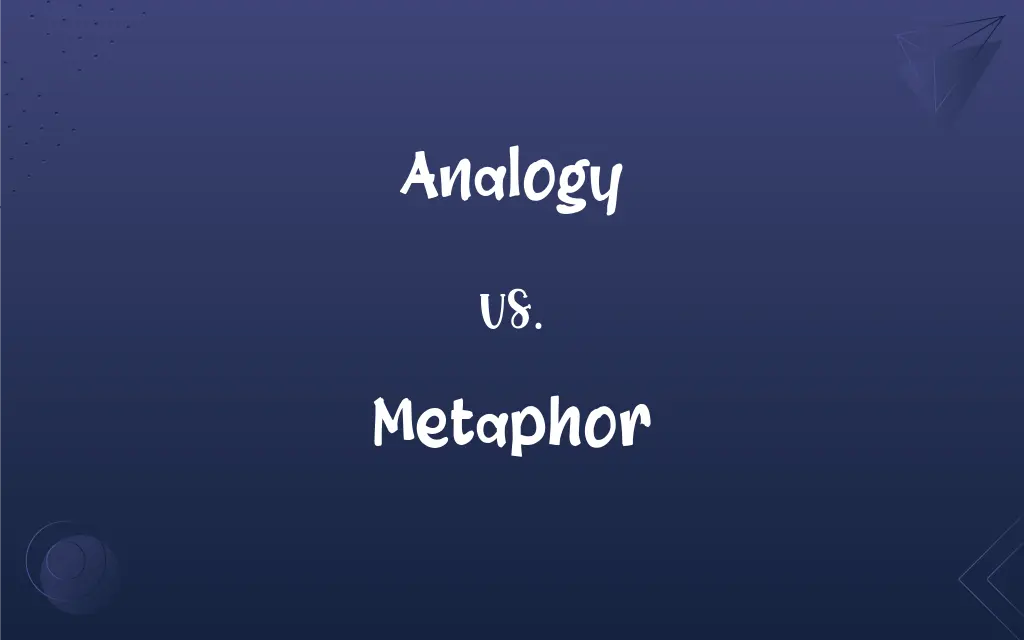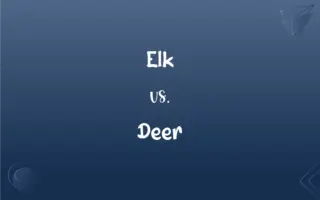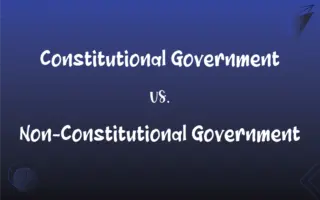Analogy vs. Metaphor: What's the Difference?
Edited by Janet White || By Harlon Moss || Updated on October 3, 2023
Analogy refers to a comparison in which an idea or thing is compared to another thing that is quite different from it. Metaphor refers to figure of speech in which a word or phrase is applied to an object or action to which it is not literally applicable.

Key Differences
An analogy makes a comparison between two unlike things that share some characteristics. In contrast, a metaphor directly equates one thing to another to highlight a shared quality, even though the two are inherently different. Analogy functions to argue or explain a point by reflecting it in a familiar context, whereas metaphor seeks to imply inherent similarities and create a direct image or concept.
When employing an analogy, one may say, "Just as a sword is the weapon of a warrior, a pen is the weapon of a writer." It seeks a relationship based on similarities between two concepts or ideas. In contrast, metaphors might be constructed as “Time is a thief," with no explicit acknowledgment of the differences between the compared entities, just a straightforward equivalence.
Analogies are detailed and logical, often utilized to clarify or explain complex topics by comparing them to simpler, more familiar ones. On the other hand, metaphors can be poetic and emotional, aiming to convey intangible or complex notions through more immediate, sensory comparisons without necessitating logical or detailed relationships.
An analogy is often a thought-out, rational argument or explanation, explicating how two things, which are not alike in most ways, are similar in one significant way. A metaphor, however, is an immediate, often emotional representation that enhances understanding or emotional resonance by aligning disparate entities as one.
In essence, an analogy seeks to explain, argue, or make things clearer through logical comparisons, while a metaphor intends to create an impact or produce profound insights through imaginative juxtapositions without needing a rational basis.
ADVERTISEMENT
Comparison Chart
Definition
A comparison to clarify or explain
A direct equivalence without needing literal applicability
Use
Often used to explain or argue
Utilized to express ideas poetically and emphatically
Structure
Expresses relationship (A is to B as C is to D)
Asserts an equivalence (A is B)
Logic
Operates through logical, often detailed comparison
Can bypass logic for emotional or conceptual resonance
Complexity
Can be more detailed and elaborate
Tends to be succinct and impactful
ADVERTISEMENT
Analogy and Metaphor Definitions
Analogy
A comparison to highlight a point of similarity.
As a doctor heals the body, so an educator heals ignorance.
Metaphor
A figure of speech equating one thing to another.
The world is a stage.
Analogy
Establishing a relationship based on parallels or connections.
Like a captain navigates through the sea, a leader navigates through difficulties.
Metaphor
Using a tangible thing or concept to represent something intangible.
The fog of despair clouded his thoughts.
Analogy
A similarity between like features of two things.
Just as a caterpillar turns into a butterfly, seedlings grow into mature plants.
Metaphor
Implied comparison achieved by calling one item another.
The classroom was a zoo.
Analogy
An argument or reasoning where one similar instance is used to infer a second similar instance.
If you can dance salsa, you can certainly learn to dance merengue.
Metaphor
A symbolic term or phrase used to denote another.
He is a lion in battle.
Analogy
Explaining or clarifying something unfamiliar through something familiar.
The structure of an atom is like a solar system.
Metaphor
A word or phrase for one thing used to refer to another to suggest similarity.
Time is a thief.
Analogy
A similarity in some respects between things that are otherwise dissimilar
Sees an analogy between viral infection and the spread of ideas.
Metaphor
A figure of speech in which a word or phrase that ordinarily designates one thing is used to designate another, thus making an implicit comparison, as in "a sea of troubles" or "All the world's a stage" (Shakespeare).
Analogy
A comparison based on such similarity
Made an analogy between love and a fever.
Metaphor
One thing conceived as representing another; a symbol
"Hollywood has always been an irresistible, prefabricated metaphor for the crass, the materialistic, the shallow, and the craven" (Neal Gabler).
Analogy
(Biology) Correspondence in function or position between organs of dissimilar evolutionary origin or structure.
Metaphor
The use of a word or phrase to refer to something other than its literal meaning, invoking an implicit similarity between the thing described and what is denoted by the word or phrase.
Metaphor
A word or phrase used in such implied comparison.
FAQs
When creating analogies, is it necessary to maintain consistent tense and voice throughout the comparison?
Yes, maintaining consistent tense and voice is crucial in analogies to ensure clarity and coherence in the comparison being drawn.
What is the primary grammatical structure of an analogy?
An analogy typically uses a parallel structure, often expressed as "A is to B as C is to D."
Can analogies and metaphors exist within single sentences or only in larger contexts?
Both can be used within a single sentence, but analogies can also be expanded upon in larger contexts for detailed explanations or arguments.
Can metaphors become clichés and lose their impact in communication?
Yes, overused metaphors can become clichés and may lose their effectiveness in conveying vivid or original images and emotions.
Can an analogy be effectively transformed into a metaphor while preserving its original meaning and impact?
Transformation might be possible but challenging, as turning an analogy into a metaphor could alter the depth, detail, and explicitness of the comparison.
Are metaphors used differently in formal vs. informal language?
Yes, formal language might employ metaphors that are conventional and widely understood, while informal language might utilize more creative, colloquial, or idiomatic metaphors.
Is it possible to create a valid analogy even when comparing inherently contradictory or opposite concepts?
Yes, analogies can compare opposites if there is a valid point of similarity that serves the purpose of explanation or argumentation.
How do metaphors vary in their grammatical complexity across different forms of writing, such as poetry vs. prose?
In poetry, metaphors might be more abstract, employing various literary techniques, whereas, in prose, they may be more straightforward and contextually bound, adhering to conventional grammar and usage.
Are analogies always used for serious comparisons, or can they be used in a humorous context?
Analogies can certainly be used in humorous contexts, comparing disparate or unexpected elements for comedic effect.
How is a metaphor commonly structured in a sentence grammatically?
Metaphors are usually structured as direct equivalences, stating "A is B."
Can a metaphor be constructed using different grammatical moods (indicative, imperative, subjunctive)?
Yes, metaphors can be constructed in different moods, but it’s vital to ensure that the intended meaning or emotion is effectively conveyed.
Is it possible to construct an analogy where more than two pairs are compared?
Yes, while traditional analogies involve two pairs, extended analogies can compare multiple pairs to build a more complex argument or explanation.
Can metaphors be extended across multiple sentences or paragraphs while maintaining a central comparison?
Yes, extended metaphors can span across multiple sentences or paragraphs, threading a single comparative concept throughout a piece.
How do metaphors cater to universal understanding considering cultural variations in symbolisms and meanings?
Metaphors might not always cater to universal understanding due to cultural variations and may need to be adapted or explained in multicultural or international contexts.
In terms of grammatical correctness, can a metaphor replace an analogy in a sentence without altering the structure?
Not always, because while metaphors tend to be straightforward (A is B), analogies might require a more detailed structure to elucidate the relationship between compared elements.
Can analogies be constructed by comparing across different grammatical categories (e.g., nouns to verbs)?
Ideally, comparisons should be made within the same grammatical category to ensure clarity and logical coherence, though creative writing might explore cross-category analogies.
Can analogies involve comparing more abstract concepts, or should they be tangibly similar to be effective?
Analogies can compare abstract concepts, but they should have a logical or thematic similarity to ensure the analogy effectively clarifies or explains.
Can metaphors intentionally be ambiguous, or should they always provide clear comparisons?
Metaphors can be intentionally ambiguous, especially in poetic or artistic contexts, to evoke multiple interpretations or emotions.
Does an analogy always involve two pairs of words or phrases?
Typically, yes. Analogies usually compare two sets of words or phrases to illustrate a point of similarity between them.
Can metaphors and similes be used interchangeably in a sentence, maintaining grammatical and logical coherence?
Not always. Though both metaphors and similes draw comparisons, similes use “like” or “as” for comparison, while metaphors do not, which might affect grammatical structure and meaning.
About Author
Written by
Harlon MossHarlon is a seasoned quality moderator and accomplished content writer for Difference Wiki. An alumnus of the prestigious University of California, he earned his degree in Computer Science. Leveraging his academic background, Harlon brings a meticulous and informed perspective to his work, ensuring content accuracy and excellence.
Edited by
Janet WhiteJanet White has been an esteemed writer and blogger for Difference Wiki. Holding a Master's degree in Science and Medical Journalism from the prestigious Boston University, she has consistently demonstrated her expertise and passion for her field. When she's not immersed in her work, Janet relishes her time exercising, delving into a good book, and cherishing moments with friends and family.































































